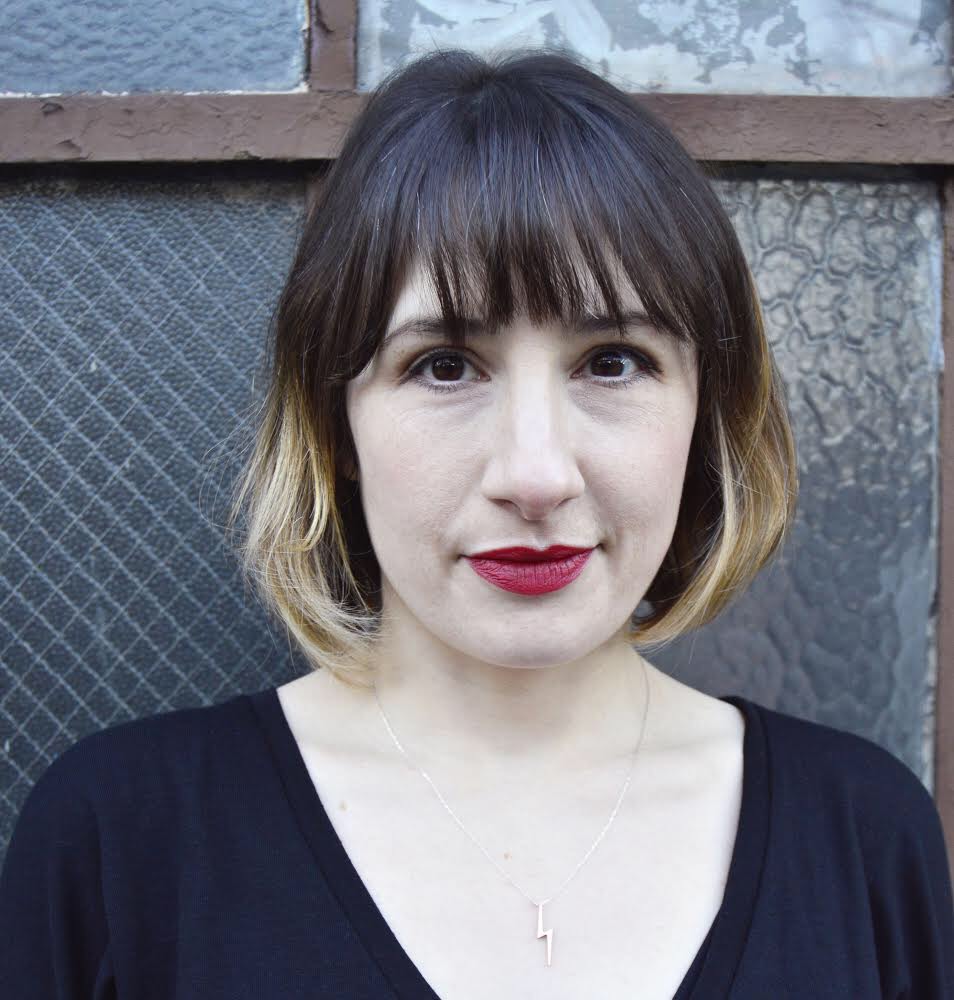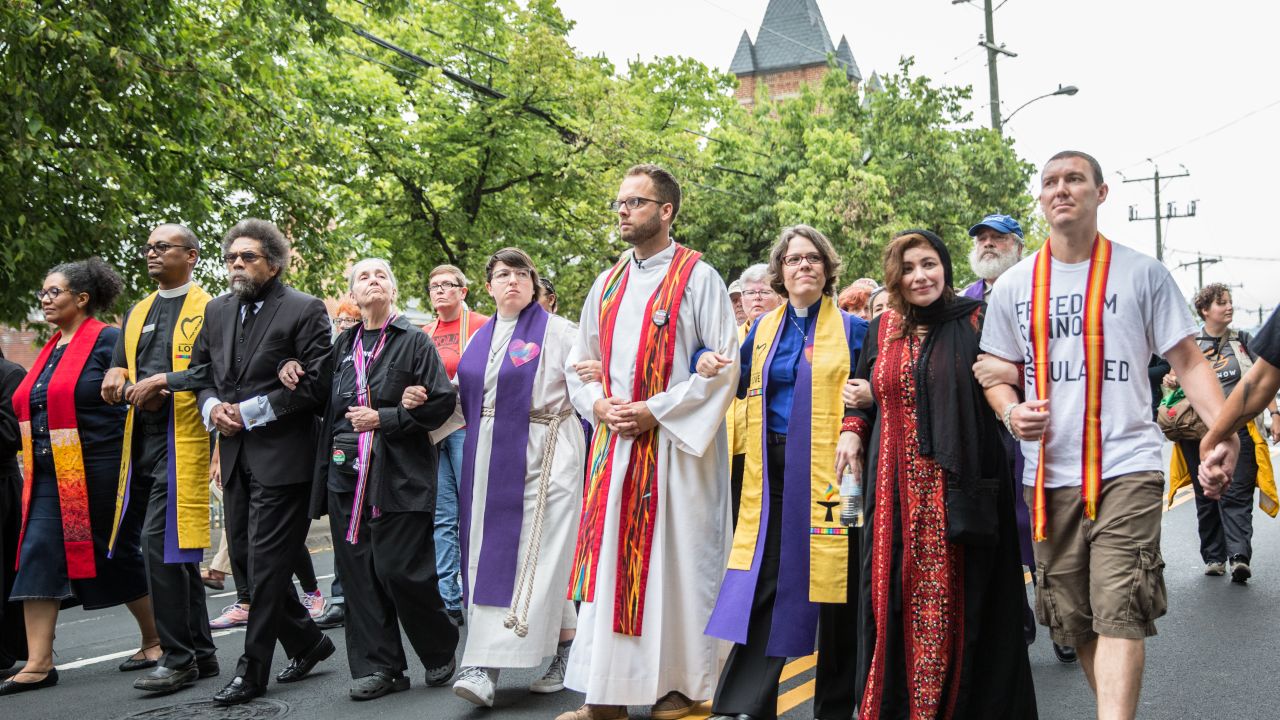
Clergy protesting at at the march in Charlottesville, Virginia on Aug. 12, 2017. (Photo by Jill Harms)
This Q&A is part of Sarah Jaffe’s series Interviews for Resistance, in which she speaks with organizers, troublemakers and thinkers who are doing the hard work of fighting back against America’s corporate and political powers. This interview has been edited for length and clarity.
The events over the weekend in Charlottesville, Virginia have resounded across the nation. It took the president three days to condemn the white nationalist, neo-Nazi and KKK groups gathered to spread fear and hatred among the community of Charlottesville and the nation at large. Sarah Jaffe spoke with Lisa Woolfork of Black Lives Matter Charlottesville about how a strong coalition of groups counter-programmed the day of the march from beginning to end.
Sarah Jaffe: How are you holding up?
Lisa Woolfork: No black woman, like myself, would have been wandering around anywhere down here by themselves yesterday. So, that is a big shift.
SJ: So the last time there was a white supremacist rally in Charlottesville was not that long ago.
LW: We had that torch rally around the Lee statue. I think in May they had an event. In July, of course, the Klan. Then, August, it is this one. We have started calling this the Summer of Hate.
SJ: This one was obviously a bit of an escalation for them, but tell me how your went day yesterday. What was going on where you were?
LW: I began the day at the First Baptist Church on Main Street. It is a historic African-American church that did a service to galvanize people to come out and stand up for their community. There were wonderful messages given there. Rev. Traci Blackmon from the United Church of Christ, she spoke. Cornel West, who is a well-known activist, he spoke. There were song selections. The service a sunrise service and began at 6 a.m. Then, we walked over to the Jefferson School and a group of us proceeded from there to McGuffey Park.
At McGuffey Park, there was programming. There was a gigantic live theatre puppet show with a gigantic puppet of Sally Hemings that was 15 feet tall and other props to tell the story about Charlottesville and the march. That was by a wonderful team of very creative activist artists. It is a community called Charis Community. That is just an example of, basically togetherness.
SJ: Particularly coming into this rally, what was the plan that folks had for dealing with this day?
One of the strengths of coalition based activism is that it allows for a variety of approaches. Unlike the Klan rally, which was much more focused on a particular single place and time — I was involved in different seminars and symposia surrounding that, as well as some activism on the ground — this was much more dispersed. We understood that this was not meant to be a one and done type gathering for the “alt-right.” It was meant to be basically a weekend party where they would come in on Friday and then they leave on Sunday.
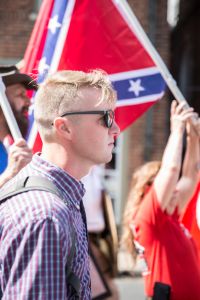
Charlottesville march on Aug. 12, 2017 (Photo by Jill Harms)
Our goal was to help pull the community to respond to the larger, more capacious threat of the “alt-right” and the white supremacists, neo-Nazis, white nationalists were representing and threatening to bring forward. I think we were able to do that. We were able to bring together a variety of people, several groups issued individual calls. The clergy, for example, had a really wonderful one calling on, in particular, white people of faith, white ministers, white clergy to come and join in taking a stand against not just explicit violent racism, but also the subtle institutional racism that their own institutions had created and cultivated over time. It was I think a really powerful soul searching on the part of the clergy, for example. I was very gratified and encouraged to see that so many in the community, as well as visitors and people from other allied organizations and people who had no connection to Charlottesville and weren’t members of any kind of organization. They just wanted to come out and stand on the side of justice.
SJ: Obviously, these people were drawn to Charlottesville not because Charlottesville is uniquely welcoming to white supremacists, but because the symbols there are meaningful to them.
LW: Yes, absolutely. One thing that I like to impress upon is that I think it is very important to retain attention on the Confederate monument. Of course, many people are turning to Louisiana and New Orleans as an example of a mayor who decided to step up and say, “No more. These are relics of a racist past and I want us to build a better future as a city. We do not need these any longer. They have outlived their usefulness.” Charlottesville has not done that. They have not done a complete process of reckoning. There was a commission that worked hard to uncover lots of very interesting information about Charlottesville’s unique Southern history, but the recommendation that they made — there were two recommendations. One was to remove the statue and the other was to re-contextualize them in place.
I have always been against the re-contextualization argument, because I don’t believe that you can make a huge monument to the Confederacy mean anything other than a monument to the Confederacy. The Monument Fund is the organization that sued the city in court when the city council voted to remove the statues. Now, mind you, they voted to remove them from one place to another. The Monument Fund said in their argument in court was that if the statues were to be moved, it would do them irreparable harm. I really think that we need to concentrate on that claim.
What does it mean that someone’s personal identity is bound up in a racist confederate monument, a monument to white supremacy? For me, the argument about re-contextualization has already been made. I think the best and most honest context for these monuments is white supremacy. Nothing says what these monuments really mean like a thousand white supremacists coming to defend them.
— Lisa Woolfork
SJ: Speaking of the symbols, there was the controversy about them wanting to have their rally in this particular park that had just been recently renamed, having been named for Robert E. Lee, right?
LW: Yes, that is right. We have a Robert E. Lee statue and that is in Lee Park. Then there is a Stonewall Jackson statue and that was always called Jackson Park. So, they changed Jackson Park to Justice Park and they changed Lee Park to Emancipation Park.
SJ: So the white supremacists had complained and sued over wanting to be able to have their rally in this particular park, even though the city had ruled that they could not.
LW: Yes. They did. They were helped by the Rutherford Institute, which I believe concentrates on free speech issues and constitutional issues here in Virginia. And, they were aided by the ACLU Virginia chapter. The judge, not the city, the judge ultimately ruled that they could hold their rally in Emancipation Park. It was around not wanting a “heckler’s veto” to change anybody’s unpopular views. The judge ruled and sided with the “alt-right,” with the white supremacists, with the Nazis, with the white nationalists.
SJ: At whatever point that their gathering was ruled unlawful and they were pushed out of the park, tell us what happened because that seemed to be when the real violence broke out.
LW: Seeing the Nazis and the “alt-right” retreat from Emancipation Park after their event was declared an unlawful assembly — that was quite a parade of hate. As they were leaving the area, they threw flares, they spit on people. There were several altercations of shouting matches and shoving matches. But still, it was a very powerful display of how love conquers hate. To stand there shoulder to shoulder to shoulder with neighbors, with colleagues from my department in English, with other faculty from around the university that I have seen a few of, from people in my own organization representing Black Lives Matter Charlottesville, which is a very small and new group, has since developed allied connections.
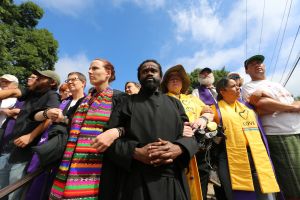
Anti-racism protest in Charlottesville, Virginia, on Aug. 12, 2017. (Photo by Heather Wilson)
That we had worked to reclaim in some small part that promise that America makes to all of us and that is the promise of equity, the promise that the Constitution shouldn’t be used as a battering ram, it shouldn’t be used as a weapon to deprive other people of rights. That was pretty heartening.
I would say that the real violence was allowing these confederate monuments to remain in the center of our city as a paean or a testament or an endorsement of not just 19th-century white supremacy, but 21st-century endorsement or tolerance of white supremacy. I think that is something that I would certainly emphasize. There are so many ways to think about and define violence.
— Lisa Woolfork
SJ: Let’s talk about the organizing leading up to this.
LW: The way that we have been working is in a coalition basis. We believe that we are stronger together than separate. Groups like Congregate, which is a collection of different faith organizations and pastors, ministers, rabbis from a variety of different faith traditions, SURJ, Showing Up for Racial Justice and Black Lives Matter Charlottesville are a constellation of groups that are trying to mobilize our community for the greater good.
SJ: You said you were on your way to a vigil. Tell me, what is next? What are people planning going forward from this weekend?
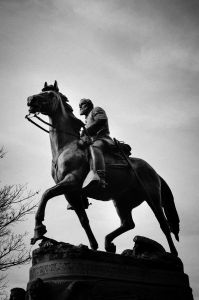
Thomas Jonathan “Stonewall” Jackson monument, Charlottesville, Virginia. (Photo by Bob Mical/ flickr CC 2.0)
LW: As a coalition, our goal is to continue in the vein in which we have started. I know, particularly, that Charlottesville Black Lives Matter is interested in talking more about the Confederate statues and how these monuments should be removed and how the city council should work hard to fight in court against the legal challenges that we might face. We want the city council to basically care as much about the lives of citizens as they did about preserving the rights of the “alt-right” when they allowed their permit to go through. We want the city to be committed to questions of racial justice and to appreciate that in the age in which we are living racist rhetoric is not just talk. Racist rhetoric produces racist actions. Racist statues are not just art. Symbolic racism is rooted in actual racist actions.
SJ: How can people keep up with you and with Charlottesville BLM?
LW: Please check Charlottesville BLM’s Facebook page. We do a lot of updates through there. We also have a Twitter feed. They can follow us there, as well.
Interviews for Resistance is a project of Sarah Jaffe, with assistance from Laura Feuillebois and support from the Nation Institute. It is also available as a podcast on iTunes. Not to be reprinted without permission.

